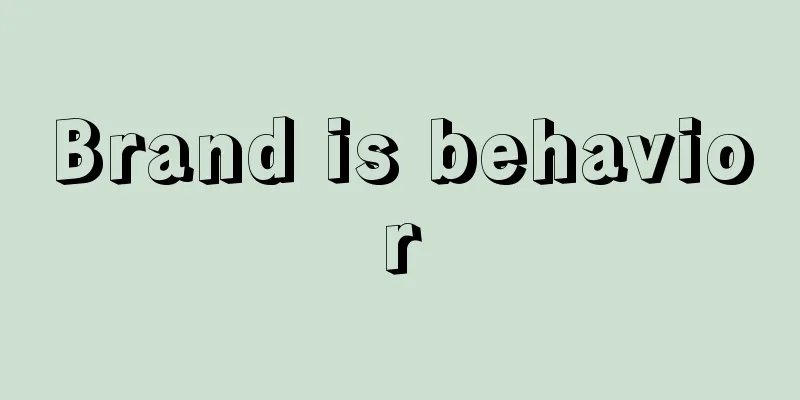Brand is behavior

01The progress and development of brand marketing mainly comes from the development of the underlying core theory. Traditional brand marketing is mainly based on psychology, while modern brand marketing is mainly based on behavior (of course, marketing is also a highly comprehensive discipline, integrating sociology, psychology, behavior, and genetics). In the past, in order to influence consumers' purchasing decision-making process, when doing brand marketing, enterprises and professional companies mainly focused on various psychological variables, such as consumer cognition, consumer attitudes, emotional factors, learning, and memory, from which various marketing theories were derived. For example, brand theory focuses on influencing people’s attitudes and emotions, while positioning theory (actually positioning is just a method, not a theory in the true sense) focuses on influencing memory structure. The most classic consumer link model AIDMA divides people's decision-making into five stages: attention, interest, desire, memory, and purchase. The first four factors are psychological variables, and only the last one is a behavioral variable. 02Since 2010, with the development of mobile Internet technology, big data technology and algorithm technology, most consumers have been online 24 hours a day. Every person who can access the Internet has their behavior track captured and retained by different platforms, forming consumer behavior data. Different behaviors are packaged into "crowd consumption behavior packages" for precise sales, and merchants can quickly invest in traffic after purchasing. Corporate brand marketing has also begun to pay more attention to various consumer behavior variables. In current brand marketing, among the consumer AISAS we often use, only the first two, Attention and Interest, are psychological variables, while the last three, Search, Action, and Share, are behavioral variables. In recent years, the concept of "growth hacking" has become very popular. The growth hacker model AARRR goes one step further. Compared with all previous consumer models, whether AIDMA, AISAS, SIPS, AIPL, 5A, etc., the most essential difference is that every link of AARRR is a behavioral variable. Acquisition is a behavior, activation is a behavior, retention is a behavior, revenue is a behavior, and referral is a behavior. Since it is a behavior, it means that every step of the relationship between the brand and the consumer can be quantified through data, so it is possible to understand and control consumers more accurately, and then provide precise direction and guidance for brand marketing. In 2017, I organized some marketing companies on the island to write a book called "Three Major Marketing Algorithms". In the preface, I wrote the following point: Except for love, everything can be evaluated and quantified. Data and algorithms are the carriers of expressing value. 03Although from a purely academic perspective, psychology and behavioral studies have a very close connection and intersection, and the behavioral school itself is also a branch of psychology. However, from a marketing perspective, the biggest difference between behavioral variables and psychological variables is that behavior is an objective existence that can be quantified, while psychology is an elusive subjective conjecture. Therefore, in the practice of brand marketing, we still separate the analysis of consumer psychology and consumer behavior, so that we can provide more practical guidance. Behavior can be directly reflected in the data; while psychology can only be inferred through questionnaires, consumer interviews, and behavioral data. For example, if a person likes to party and participate in various social activities (behavior), then you can infer that this person is extroverted, confident and sunny (psychological). 04The parent disciplines of marketing are economics and social behavior (as well as psychology). Economics is the father of marketing, and social behavior is the mother of marketing. Most of the marketing theories we know today are based on psychology, but I believe that future marketing theories must be based on behavioral science. This change from psychology to behavioral science has greatly changed the way of building brands. 05Brand building in the traditional era comes from the packaging of things. We package products with a name, a trademark, a symbol; a selling point, a positioning; an image, a story, a cultural value. We try to integrate psychological added value such as attitude, emotion, and personality into physical products, so as to win consumers' recognition and purchase, and make the products generate premiums. Brand building in the digital age comes from the operation of people. The various concepts and marketing tools we often talk about today, such as scenarios, communities, fans, interactions, private domains, and traffic pools, all start from how to connect with consumers and build relationships. If you can identify a group of users, then in theory you can sell them whatever you want. And when you build a relationship with consumers, they will spontaneously fall in love with you, support you, and stand by you. The reason why online celebrities are so popular with live streaming, such as Xiao Yangge, is actually a reflection of the gradual changes in business. The fact that Li Ziqi's brand of snail rice noodles is so expensive and still so popular is also closely related to the shift in the focus of brand marketing. Currently, brand marketing is at the crossroads of transition and transformation. If companies want to upgrade their brand marketing, they must take a two-pronged approach, combining brand building in the traditional era with brand building in the digital era to achieve corporate growth. 06I am a running enthusiast and I pay a lot of attention to sports brands. I am also a heavy consumer of sports brands. In recent years, the domestic running shoe brand Xtep has been rising rapidly, while in the Chinese market, the halo of brands such as Nike and Adidas seems to be disappearing. The fate of Reebok, another well-known sports brand once owned by Adidas, is even more miserable. In the few marathon competitions such as the Shanghai Marathon and the Xiamen Marathon last year, few people wore Reebok shoes. You may not know that Reebok once occupied the throne of the number one sports shoe brand in the world and has a glorious history. It invented the world's first pair of spiked running shoes and inflatable sports shoes. And fewer and fewer people are wearing Adidas running shoes. Judging from the performance in the Chinese market, Xtep's performance in branding in the digital age is much better than the two international giants. Xtep's new high-end running shoes are also recognized by more and more runners. 07In fact, the root cause of Adidas' decline in the past two years is not that they didn't work hard, but the outdated brand marketing concept. Let's take Reebok, which is owned by Adidas, as an example. In recent years, Reebok has actually done a lot of brand upgrades. Starting with replacing the brand LOGO, the old LOGO was changed into a new one that is more distinct and powerful, symbolizing the physical, spiritual and social changes that fitness brings to people, and is more in line with the direction of fitness. The channels have also changed accordingly. Reebok has signed contracts with several chain gym brands to carry out brand communication in the gyms and cooperate in developing fitness courses. It has signed many spokespersons in China, including Wang Deshun, Yuan Shanshan, Wu Lei and others. The company also used a lot of new tricks in communication. In early 2015, Reebok launched the largest brand communication campaign in the company's history in the past 10 years, and also invested in the Super Bowl advertisement, which is known as the "American Spring Festival Gala". The theme of this campaign is called "Be More Human", which is translated into "Refine to Me" in China. It means to explore one's own limits and become a stronger self. 08This series of measures did not help Reebok regain its former glory, and it ended up being sold. Moreover, the sale price was only 2.5 billion US dollars, compared to the 3.8 billion US dollars when Adidas acquired Reebok. The root cause of Reebok's failure was that its brand marketing ideas could not keep up with the new era. It did not make a change in marketing from the bottom up. 09In 2016, I published a best-selling financial book, Circle Business. In this book, I spent a lot of space talking about a brand that was not well-known in China at the time, called lululemon. The way lululemon built its brand was to use the brand marketing method of the digital age. Lululemon did not have a marketing department, rarely advertised, and had never hired a big brand as its spokesperson. So what is it relying on to achieve growth? In particular, its main product yoga pants, which sell for about 850 yuan, is more than twice the price of similar products from Nike, Adidas and other brands. Why can lululemon do this? Let me share with you. 10Lululemon has built a systematic user community, which is spread through product educators, brand ambassadors, and user groups. Lululemon calls all its employees product educators, requiring them to be familiar with products and businesses like experts, so as to educate users well. When recruiting store managers, lululemon gives priority to people from the news and coffee industries rather than those with a retail background, because lululemon believes they are better at accepting and spreading brand culture. Lululemon even encourages executives and employees to take a mind-opening course called "landmark" to stimulate their "true potential." The purpose of all this is to better spread the brand culture. In the end, lululemon's black pants transcended the product itself and were given a greater meaning. Not only did they change from professional fitness scenes to women's daily clothing, but they also became a symbol of women's awakening consciousness. 11On the other hand, every time it enters a city, lululemon will dig out the 20 most popular local fitness coaches, yoga teachers, and dance teachers. From these candidates, lululemon will eventually select 4-5 winners as store ambassadors. The store will provide ambassadors with free clothing, design courses for them, and shoot promotional videos and photos for them; it will hang posters of them wearing lululemon products in the store; it will also put their promotional photos in local newspapers and indicate the name of the ambassador's yoga studio. In this way, brand ambassadors can guide traffic to stores. As a highly educated elite group, ambassadors wear lululemon to show off their toned bodies and smooth muscle lines, which is the best advertisement for the brand and has a strong demonstration effect on ordinary consumers. 12With the support of this user strategy, each store of lululemon has become a user base. Every time a store is opened, lululemon will do four things first:
13Based on this user and store operation strategy, we can see that lululemon has gone through the process of "niche group loyalty → reputation formation → popularity expansion" in brand development. First focus on the community, and through interaction with these users and word-of-mouth spread, it will eventually become a well-known social brand. Community, social networking, and society are the growth path of a social brand. 14The goal of brand communication is not just to spread an idea or slogan, but to influence actions. Compared with the functional, emotional, and value-oriented approaches that try to persuade consumers and make them fall in love with the brand, brand social networking and private domain operations directly start from consumer behavior and are more fundamental. Gabriel Tarde, one of the three founders of French sociology, has a classic assertion: communication is imitation. He used the two factors of invention and imitation to explain all social life phenomena, and believed that human society is a cycle of invention, imitation, conflict and adaptation. Someone invented new ideas, new concepts, new technologies, and new products, which then triggered imitation by the masses. In the process of innovation diffusion, it conflicts with people's inherent cognition and traditional habits, and eventually forms adaptation. Imitation is the soul of social life, the most basic social phenomenon, and the ultimate element of social behavior. Human beings are a group of individuals who imitate each other, and our society is composed of the spread and exchange of personal emotions and ideas caused by imitation. The relationship between people is mainly a relationship of imitation. Therefore, Tarde said that imitation is communication. This sentence explains how advertising and brand communication work on consumers and help sales. The ultimate goal of a company's brand communication is to get consumers to imitate the characters and behaviors in the advertisements and buy and use the products. The ultimate goal of communication is to make consumers imitate from concepts, words to behaviors. The brand is passed on by word of mouth, and the group consumes and uses the brand. 15Today, the various content on social media is mainly used to influence others to imitate by demonstrating lifestyles. For example, sex in the morning and sex at night, camping, and water-based makeup are all memes. Good lifestyle marketing must be injected with memes. In the above content seeding, another point that cannot be separated is the role of KOL as a model. Tarde summarized the laws of imitation, the first of which is called the law of descent. This means that imitation is often from top to bottom, and low-status classes and individuals always imitate high-status classes and individuals. This is imitation that radiates from high to low. The second law of imitation is called the law of first the inside and then the outside. It means that imitation is from the inside to the outside. Any imitation behavior is first ideological imitation, then material imitation. The spread of ideas precedes the spread of expression. Therefore, in order to form imitative social behavior, ideas and concepts must come first. 16In 2023, when companies upgrade and improve their brand marketing, they must first improve their brand marketing concepts and then upgrade and improve their brand marketing. In this way, you can avoid following Reebok's old path. Author: Liu Yichun Source: WeChat public account "Liu Yichun's Brand Business Innovation (ID: shangyeyiguohui)" |
>>: Let the brand have the light of humanity
Recommend
How is Amazon's payment cycle calculated? What are the payment methods?
It is not easy to operate an Amazon store. Althoug...
Wang Po stopped, but Henan did not
This article explores in depth how the "Wang ...
Video account is about to usher in a major upgrade
This article starts with the major update of Video...
How can an individual in China run Shopee without a company? What are the conditions?
Nowadays, most people prefer to start their own bu...
Is there any risk in changing the brand on Amazon? How to register the Amazon brand?
When opening a store on Amazon, you may need to ch...
Theoretical model that marketers must master: AARRR (Pirate Model or Growth Hacker Model)
Today let's learn a marketing theory model: AA...
Brand No. 1: Attack, Defense, Defend, Retreat
Combining Sun Tzu's Art of War with brand oper...
What are Shopee Ads store search ads? Why use them?
Shopee’s new advertising feature is now available:...
Data analysis empowers sales, these strategies are amazing
In today's highly competitive business environ...
Starting from a report, dismantling 3 digital banking cases
From WeBank’s technological innovation to NuBank’s...
Is Lazada Singapore easy to operate? Is Lazada still easy to operate now?
Lazada has six sites, namely Vietnam, Malaysia, Si...
Hot-selling product strategies in the new retail era: How do Sam's Club, Hema, and Luckin Coffee create hot-selling products in the retail industry?
In the new retail wave, creating eye-catching and ...
Just now! The official account can modify pictures!
Public account articles can now modify images, whi...
How much is the annual salary of an account manager at Alibaba International Station? Is it suitable for this job now?
Everyone knows about the position of Alibaba Inter...
What does offshoring mean and what are the risks?
There are many domestic e-commerce platforms and f...









